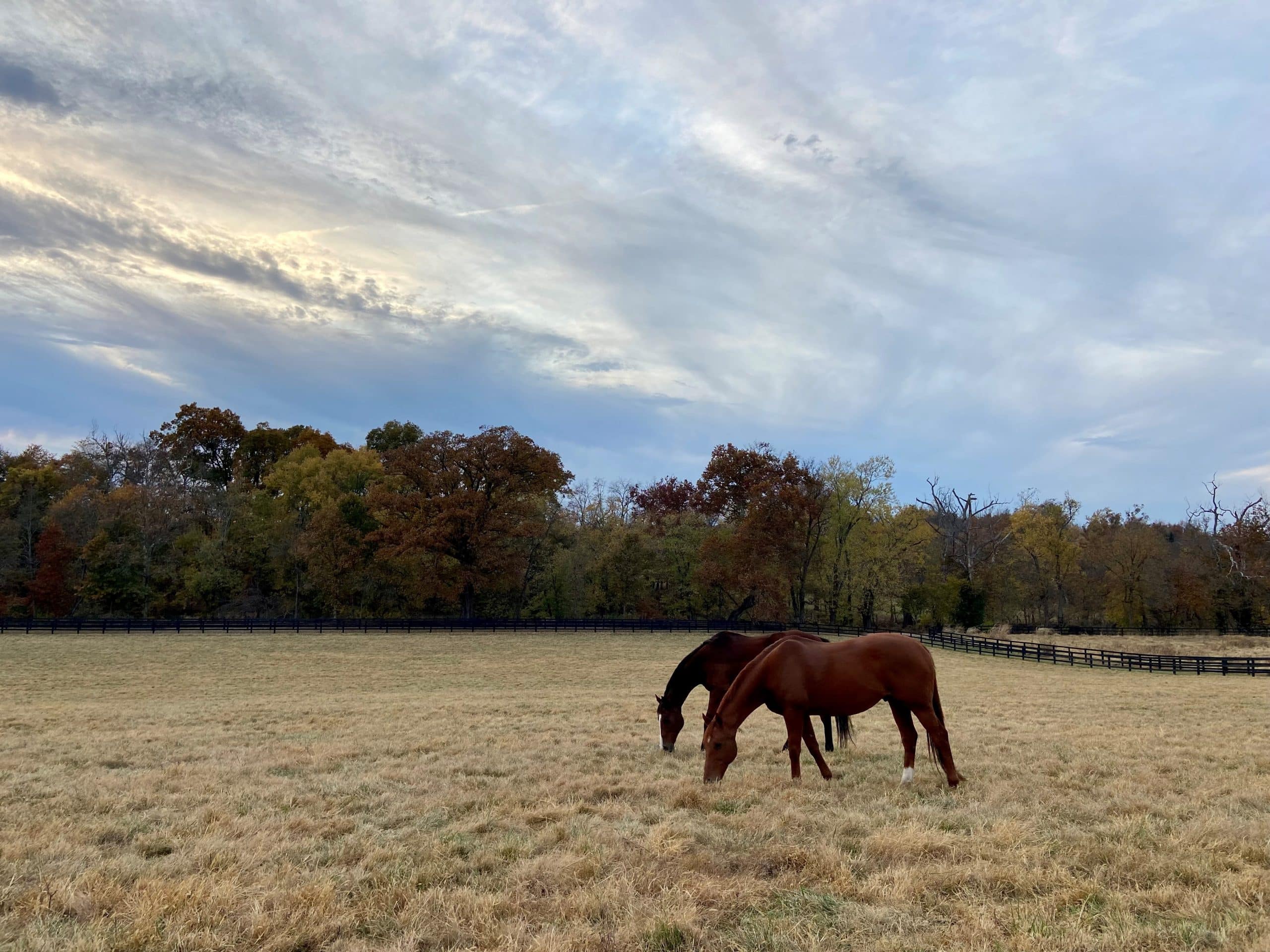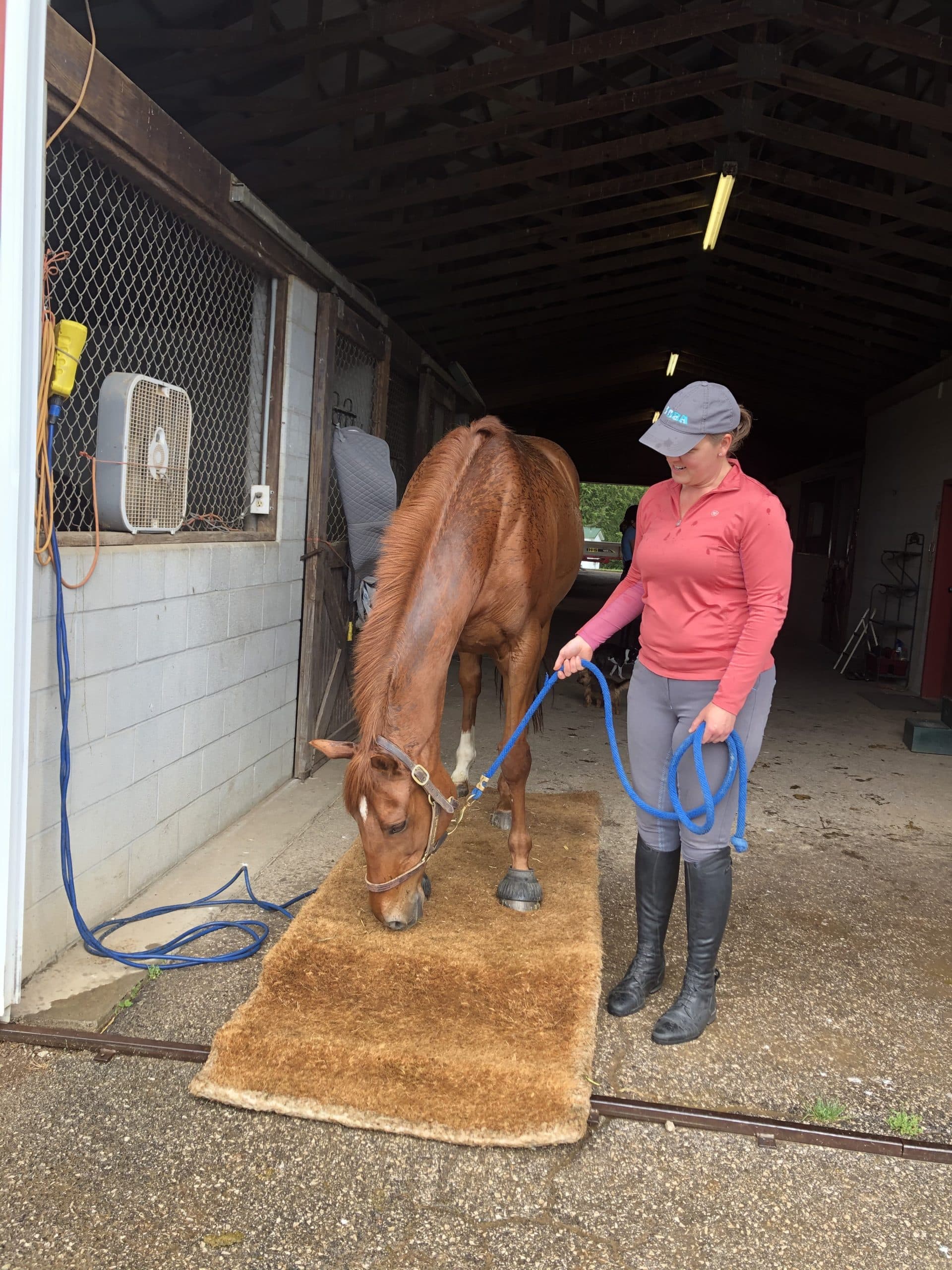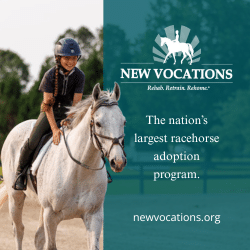
In regions where summer rains and mindful pasture rotation extend grass stands into autumn, it’s much easier to pursue forage-focused diets. Photo by Stephanie L. Church
Arguably, every horse’s diet should be forage-focused. Horses evolved as grazers, with a gastrointestinal tract that runs best on pasture, hay and other forages. But because most of our horses are athletes and need additional energy to perform, necessity and tradition have dictated we offer concentrates or other feeds as fuel — products that work well for some OTTBs but not others.
For this reason many OTTB owners have pursued high-quality forage-focused diets for their horses, with some even adopting forage-only programs. Nutritionists say this approach can be very useful, especially in horses that struggle with hindgut issues and ulcers. But as with any equine ration, owners must balance it appropriately.
Why Horses Need Forage
Feeding forage reduces risk of certain health issues, such as colic, ulcers, and — through mitigating metabolic concerns — laminitis. It can also help horses maintain a healthier body weight and condition in retirement and supports dental health by increasing chew time. (Read more on the benefits of forage at TheHorse.com/1118391.)
“Horses are supposed to be eating the majority of their diet in pasture or hay, so make sure you’re putting good hay and pasture in front of them,” says Morgan McQuerry, MS, PAS, director of emerging markets at Hallway Feeds, in Lexington, Kentucky. “I love it if people can keep hay in front of their horses 24/7. I know that’s not always easy — it just depends on the size of the farm and the number of hands helping. That also helps with boredom issues,” which can reduce stress.
Racehorses: A Need for Feed
Before we get into forage-focused diets for OTTBs, it’s important to understand why we introduced grain to horses in the first place, says Madeline Boast, owner of Balanced Bay Equine Nutrition Consulting, in Carlisle, Ontario.
Millennia ago, owners began feeding working horses grain to meet the animals’ additional energy (kilocalorie) requirements. “Also at this time, we had poor-quality forage, so the forage maybe wasn’t providing as much for the horse as we can source today,” she says.
So barley, oats, corn and other grains became a part of carriage, war and other horses’ diets, to supplement the grass and legume hays of the time.
While racehorses’ roles are sport, not transport, unquestionably they need large reserves of energy.
“When we look at a racehorse diet, they are often consuming a lot less forage and a lot more concentrate or grains than our riding horses do,” says Boast. An Australian study revealed the average horse in race training consumes 7.3 kilograms (about 16 pounds) of grain-based feed a day.
It’s impossible to maintain racehorses in training on forage alone. “But, as we are always learning more about the equine gastrointestinal tract and wanting to improve our practices for our horses, this is shifting as well, with more forage being incorporated into Thoroughbred diets,” says McQuerry, who among other equestrian pursuits has bred Thoroughbreds for racing.
The Post-Track Life: Strategies for Focusing on Forage
When racehorses head to their second-career homes, their lives wholly transform. “And so their nutrition really must change to support this lifestyle change,” says Boast. “The practices often shift with the high-performance diets to forage — maybe not to forage only, but typically forage-based.”
How you’ll adjust their nutrition depends on where you are in your post-track journey. “If you’re at the point of you’ve just gotten the horse and are transitioning them to a diet for this new lifestyle, or if you have a diet that you’ve been trying out and hasn’t been working, it would be a little bit of a different situation,” says Boast.
Begin in the same place with both scenarios: Have your hay tested (see sidebar on page 100). This will give you a starting point for meeting your horse’s nutritional requirements, which you can find at webassets.nationalacademies.org/nrh.
“Having (a hay analysis) can give you really good guidance in choosing a ration balancer that is going to complement your forage,” says Boast. Balancers are heavily fortified pellets fed alongside forage in small amounts to provide essential nutrients. You might need a balancer with more protein, for instance, if your hay is deficient.
“The next thing I normally look at is the digestible energy and the digestibility parameters on that fiber in the forage,” she adds. “So things like the NDF (neutral detergent fiber), the ADF (acid detergent fiber), the lignin, making sure those aren’t wildly high, indicating that you have a significant proportion of indigestible fiber, because that can really impact how a horse is going to maintain weight on a forage.”
Once you’ve chosen a ration balancer, you might determine if your horse needs additional energy to perform his job or maintain his body condition.
“This is when you could look at alfalfa pellets, beet pulp and, of course, oils,” says Boast. “Horses don’t have a gallbladder but do a really good job at digesting fats, as long as they’re added slowly and have time to adapt. I love adding oils for extra energy.”
However, both sources say the easiest way to increase caloric intake is with alfalfa; you’ll feed much less balancer than you would concentrate, so it can’t take on a whole lot of oil.
“I personally love whenever I can convince somebody to include some alfalfa in the diet,” McQuerry says, whether in hay, cube or pellet form. “I think alfalfa is a fabulous tool … it helps with (buffering acid in) their bellies, and it’s so packed with calories that these horses can really thrive.”
Other options for increasing calories include pelleted rice bran, flaxseed meal or a conditioning supplement (e.g., Luminance from Hallway). Boast suggests owners always soak beet pulp, hay pellets and cubes. Besides making these feedstuffs easier to consume, “water intake is great, especially if you’re concerned about colic.”

Many feed dealers have scales for weighing your horse. Photo by Stephanie L. Church
Hear Us Out: Alfalfa Is Good for Your OTTB
Some horse owners bristle at the mention of the A-word.
“Alfalfa has a very bad stigma for being too ‘rich,’ but I still haven’t come across anybody who can explain what ‘rich’ means,” says McQuerry. “I think they might mean it’s too calorically dense, or they had an experience where they just decided, ‘Let’s throw all the alfalfa in front of them!’ and the horse got a bout of diarrhea from it.”
That’s where gradual changes to a horse’s diet come in — they’re not just for switching concentrates.
“We always say to take seven to 10 days for any sort of dietary changes in a horse, and that’s including your forage program,” says McQuerry, no matter the hay type. “I think that gets forgotten in barns — the (concentrate) of your horse’s diet is actually relatively small compared to their forage and, so, when you have that immediate change in forage, you’re throwing off the whole digestive tract — all those good bugs that are living in their hindgut — and that’s when you start seeing all the diarrhea issues.”
So, if your horse is getting 10 flakes of one type of hay, for instance, swap out one flake for the new hay the first day, two on the second and so on.
Common Mistakes When Aiming to Feed All Forage
Shifting your focus to forage might come with a learning curve. Here are common mistakes McQuerry sees:
- Skimping on hay quality. “Cheaping out on hay is the No. 1 issue that you see,” she says. Seek high-quality hay and, again, test its nutritional value.
- Feeding the same amount of forage after you’ve taken away the concentrate. Hay rations must increase, often significantly.
- Feeding every horse in the barn the same amount of forage. “Having a good idea of how much that horse weighs and how much they actually need in dry matter is huge,” says McQuerry. “Two flakes each is not going to be sufficient when you have so many body types, different energy requirements, different physical needs, whatever we’re asking them to do.”
Many feed dealers have scales for weighing your horse. Once you have an initial measurement, she says, you can record what the weight tape reads and use it to help you monitor changes. (You can also make estimates with a weight tape or online tools such as TheHorse.com/WeightCalculator.)
When in doubt, again, lean on your hay testing results, your horse’s nutrient requirements and the advice of your veterinarian or nutritionist.
“Everything is going to tie back to what the values in your hay analysis tell you,” says Boast.
More Pros to Forage-Focused or -Only Diets
Some of the benefits owners have seen after transitioning horses to forage-focused diets include fewer digestive issues and better health overall, especially in cases of overfeeding — for example, previously overweight horses carrying less weight on their joints.
Forage-focused diets can also simplify a feeding program, McQuerry says. Owners only juggle high-quality hay, a balancer and the occasional supplement.
Admittedly, in regions where summer rains and mindful pasture rotation extend grass stands into autumn, it’s much easier to pursue these diets.
“These are going to be farms that are well-managed,” says McQuerry. “Their pastures are not overstocked. They tend to be more boutique operations than your major 60-horse show barns … that are not on land quite as sufficient as some of the breeding farms (you see in Central Kentucky).”
Keep in mind that while you might save money by feeding less concentrate, you will be purchasing more hay — prices for which, like most consumable goods, are rising.
Still, “if you’re managing horses on the proper space and you’re not overstocked, I think you will see some financial benefits to it,” says McQuerry.
Take-Home Message
Feeding OTTBs a forage-focused diet prioritizes their dental, gut, metabolic and mental health. Remember to address horses as individuals — what this diet looks like in one horse might be very different than how it looks in another. If you have questions, contact an equine nutritionist to help you with this process.
“The biggest takeaway is making sure you have quality forage,” says McQuerry. “It’s worth paying for the good hay, it’s worth paying a little bit more to board at a farm with great pasture … it’s worth it in the long run for your horse. It’s going to make him a healthier and happier horse.”
Hay Testing
If you’re a U.S. horse owner, you can have your hay tested by Equi-Analytical (equi-analytical.com) or ask your local extension office for options nearby.
If you’re in Canada, Madeline Boast, owner of Balanced Bay Equine Nutrition Consulting, in Carlisle, Ontario, recommends using the Cargill lab in Guelph.
If a company that isn’t equine-nutrition-focused will be testing your horses’ hay, be sure you note this on the form, so you don’t end up with cattle nutrition values.
Boast offers a reference sheet to owners seeking to test their own hay. You can email her at balancedbaynutrition@gmail.com.
Stephanie L. Church is the editorial director at The Horse. She and her OTTB gelding, It Happened Again, enjoy dressage, eventing and trail riding in Lexington, Kentucky.

